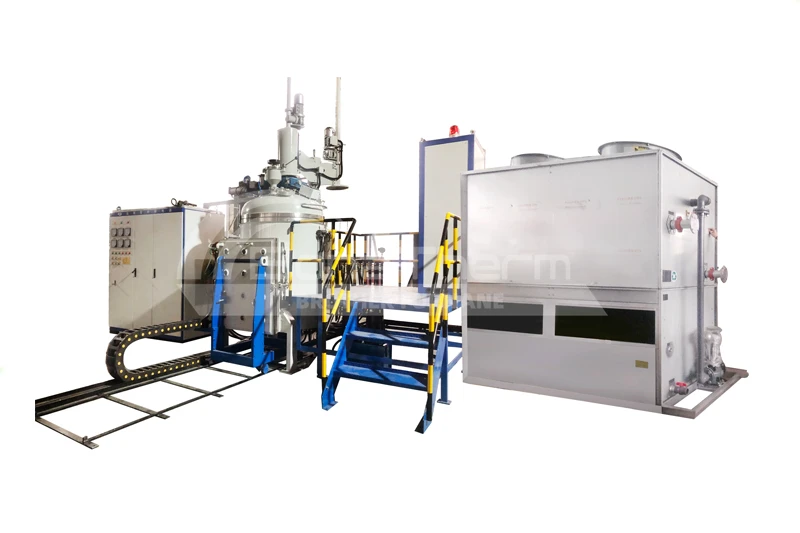seo@bonaregroup.com
Email Us

The vacuum induction melting furnace utilizes the principle of electromagnetic induction to heat and melt metal raw materials in a vacuum environment. Using an induction coil, it generates an alternating magnetic field, causing eddy currents in the metal itself to heat and melt. This reduces oxidation, removes impurities, and ensures melt purity. Capable of melting stainless steel, high-temperature alloys, and titanium alloys, it is widely used in universities and research institutes.
Starting from the internal structure, we show you the unique design logic of vacuum induction melting furnace products:

Use IGBT or KGPS medium frequency power supply.

Mechanical pump + Roots pump + diffusion pump vacuum unit.

The chamber cover is equipped with an observation window to observe the working conditions inside the chamber, and a shield is provided to avoid contamination.

PLC+touch screen.
The equipment's operating conditions, temperature, vacuum degree, and displacement data curves can be recorded and viewed at any time.
Focusing on actual scene applications, we will highlight the advantages of vacuum induction melting furnace equipment functions for you:
2300℃
6x10-3Pa
The inductor for smelting metal is located inside the furnace shell. It is made of a rectangular copper tube and is fixed to the electrode by two joints, so it is easy to install and disassemble.
A pre-sintered crucible can be placed inside the inductor, or a crucible can be rammed into the inner wall of the inductor. The refractory material used to make the crucible is related to the type of metal being smelted.
Upper limit alarm, deviation alarm, automatic stop at the end of program operation, no need for human supervision.
Vacuum induction melting furnaces can cover multiple fields and demonstrate their cross-industry adaptability and practical value:

Universities and research institutions use it to develop new alloy materials. It can accurately control the melting temperature and composition to meet experimental melting needs.

In the melting of battery materials, vacuum conditions can remove gas impurities in the materials, thereby improving battery energy density and hydrogen storage efficiency.

Melting high-speed steel and mold steel, improving the hardness and wear resistance of molds and cutting tools, reducing carbon loss in a vacuum environment, and ensuring the performance stability of materials after quenching and tempering.
Preparation of rare metal alloys for use in vacuum electronic devices to prevent impurities from affecting electrical and thermal conductivity.

Melting titanium alloys and high-temperature alloys for manufacturing key components, which require materials with both high strength and high temperature resistance. A vacuum environment can prevent oxidation loss of alloy elements.
Aiming at the characteristics of various materials, the core advantage of the product is its compatible processing:












Focus on answering common questions to provide users with clear and practical usage guidelines:
A:The vacuum environment in induction melting reduces harmful gas emissions to avoid molten metal defects like porosity, and provides sterilization by removing contaminants. With targeted refining to clear inclusions and adjust composition, it meets high-purity metal needs of aviation and electronics.
A:Choosing a crucible material suitable for the metal being melted can reduce reaction losses between the crucible and the molten metal, extending the life of a single use. Furthermore, high-quality crucibles offer thermal conductivity that better matches the characteristics of induction heating, accelerating melting speed and improving production efficiency.
A:The water flow can be adjusted according to the melting stage: increasing the flow rate to enhance heat dissipation during temperature rise, and appropriately reducing the flow rate during temperature retention. This not only meets the cooling needs of each stage but also avoids energy waste.
Present performance details with accurate data, intuitively showing the core technical specifications of the vacuum induction melting furnace:
| Types | Loading Capacity(kgs) | Rated Frequency(HZ) | Rated Power(KW) | Ultimate Vacuum Degree(Pa) | Cooling water consumption(t/h) |
|---|---|---|---|---|---|
| BR-RLL-10 | 10 | 3000 | 60 | 6x10-3 | 10 |
| BR-RLL-25 | 25 | 2500 | 120 | 6x10-3 | 15 |
| BR-RLL-50 | 50 | 2000 | 160 | 6x10-3 | 25 |
| BR-RLL-100 | 100 | 2000 | 200 | 6x10-3 | 30 |
| BR-RLL-200 | 200 | 1000 | 200 | 6x10-3 | 35 |
| BR-RLL-300 | 300 | 800 | 250 | 6x10-3 | 40 |
| BR-RLL-500 | 500 | 800 | 350 | 6x10-3 | 50 |
| BR-RLL-1000 | 1000 | 800 | 400 | 6x10-3 | 70 |
Control of all links from raw materials to finished products:
Stainless steel sheets and high-temperature-resistant alloys are selected, meeting vacuum sealing and load-bearing standards.
Cut raw materials according to design drawings using specialized equipment to ensure dimensional tolerances.
Bends and forms the sheet metal, processing the furnace shell and chamber components with a bending angle accuracy of ±1°.
Lathes are used to process precision components such as flanges and connectors, ensuring surface roughness control.
Weld the furnace body welds, ensuring airtightness on key components, and perform post-weld inspection.
Grinds and trims welded components to ensure a smooth appearance without sharp edges.
Electrostatically sprays the furnace shell and dries it.
Install the vacuum system, heating element, temperature control module, cooling system, and tighten connectors.
Conduct vacuum tests, temperature rise tests, and safety checks.
Internally cushioned with pearl cotton, externally covered with waterproof film and wooden crates, with anti-collision markings and equipment parameter labels.